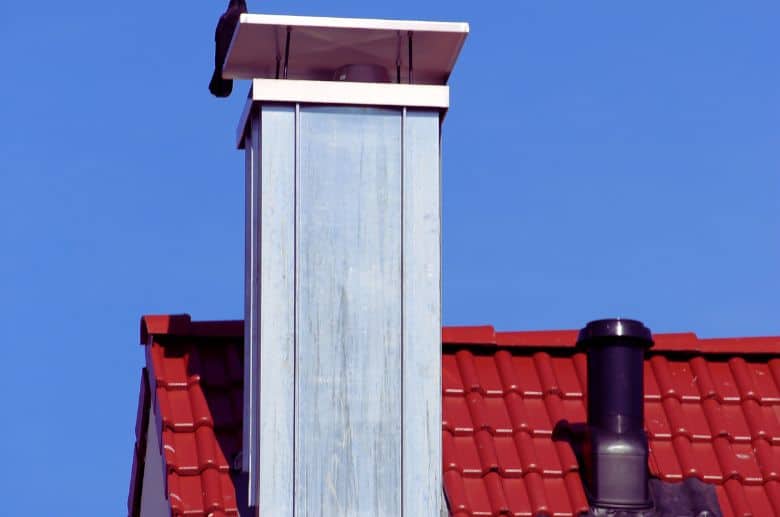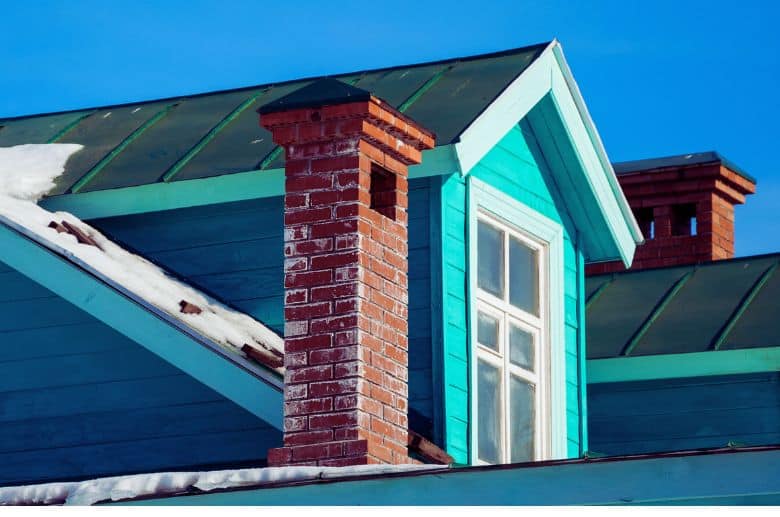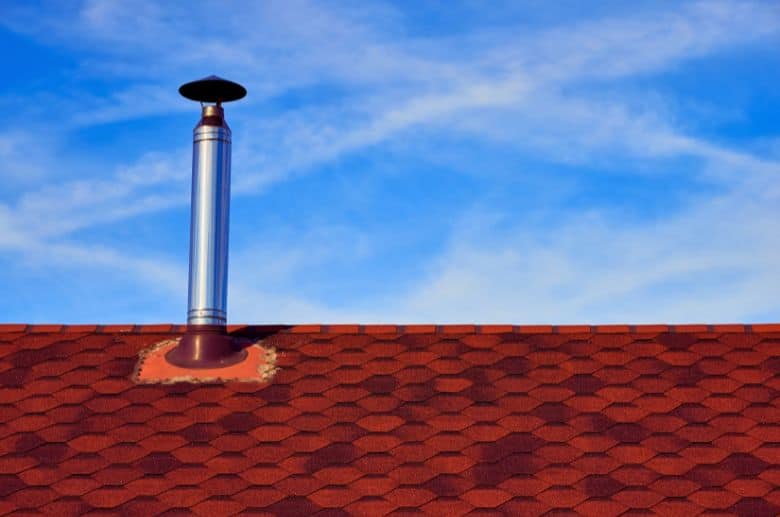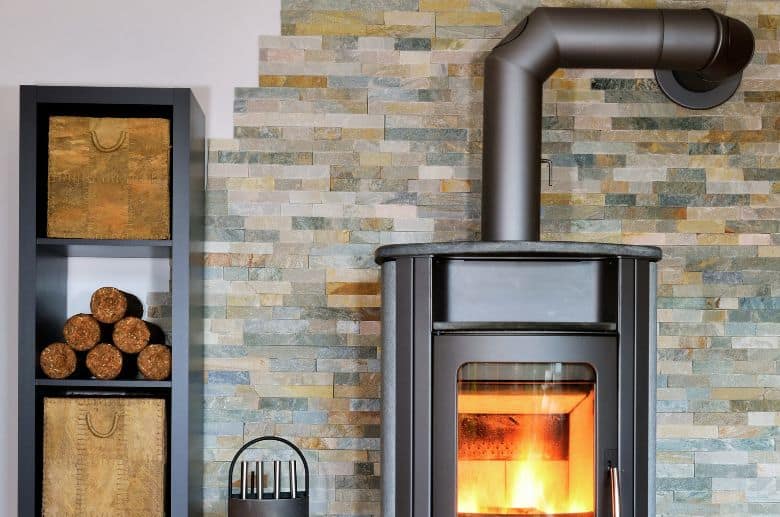Chimneys are necessary for many reasons, including effective ventilation and the safety of your home. This is because the primary purpose of a chimney is to allow smoke and other fumes to escape from your home. Plus, having a chimney can add a certain aesthetic charm to the exterior of your house.
When it comes time to choose a chimney, there are different types of chimneys you can install. But because there are multiple types of chimneys, it can take time to know which one will be the best fit for your home.
That’s why we’ve done the hard work for you and broken down some of the most popular types of chimneys, their costs, benefits, and drawbacks. Using our expertise and in-depth research, we’ve put together a comprehensive guide to help you make the best choice.
What Are the Characteristics of a Good Chimney?
A good chimney will keep your home warm and safe by removing harmful toxins from the air. These toxins include carbon monoxide and smoke and come from burning fuel, such as wood and gas.
It also helps to prevent fires by providing an escape route for sparks and embers.
To further expound on the importance of a chimney, the following are some of the key characteristics that you should consider when choosing one:
- A good chimney should effectively remove combustion products from your home, including Smoke, Carbon Monoxide (CO), and other toxic gases.
- It should also be appropriately sized for your specific needs. The standard size of a fireplace chimney is 8 in. x 12 in., but depending on your home’s layout, you may need to size your chimney up or down to ensure safe and efficient operation.
- There’s also the 3-2-10 chimney rule. This rule states that your chimney’s shortest side should be 3 feet higher from where it penetrates the roof and 2 feet higher than any part of the roof within 10 feet of the chimney.
- Another characteristic of a good chimney is that it should be constructed of heat-resistant material to ensure safe operation and prevent fires. Two types of materials commonly used for this purpose are brick and steel.
- Chimneys should also minimize the risk of condensation and help keep your home warm by providing an airtight seal.
- Most chimneys should be insulated to reduce the fire risk.
These are some essential characteristics you should consider when choosing a good chimney.
——
Do You Need to Hire Chimney & Fireplace Expert?
Get free quotes from qualified experts near you. No commitment required!
——
What Are the Different Types of Chimneys
With so many types of chimneys to choose from – including prefabricated, masonry, and metal chimneys – it’s crucial to pick one that meets your needs and provides the safest operation possible.
Let’s look at the different types of chimneys and their characteristics:
1. Factory-Built/ Prefabricated Chimneys

As their name implies, these chimneys are made in a factory and installed onsite. Prefabricated chimneys can be made from either metal or clay liners and often come with insulation to reduce the risk of fires.
They’re typically easy to install and can cost less than masonry chimneys. This is because they’re usually made of lightweight materials, making them easier to transport and position.
However, they do require regular cleaning and maintenance because they can become clogged with creosote, a byproduct of burning wood.
For this reason, they’re not ideal for those who don’t want to devote much time and effort to chimney upkeep.
The most common application for prefabricated chimneys is with wood-burning fireplaces and stoves. These chimneys are designed to withstand the high temperatures that wood-burning stoves produce.
That aside, let’s look at some of the advantages and disadvantages of prefabricated chimneys:
Pros
- Expert services: Prefabricated chimneys come with professional installation and setup assistance.
- You get a tighter fit: The prefabricated chimney is designed with specific measurements that fit the appliance it’s connected to.
- Safe and functional: Because of its professional setup, the prefabricated chimney is less likely to experience fire hazards.
- Sturdy and durable: Even though they’re made of lightweight materials such as galvanized steel, which is more resistant to heat than traditional metal pipes, making them sturdy and durable.
- Affordable than masonry chimneys
Cons
- High maintenance costs
- It needs regular cleaning and inspections
- Requires a professional installation to ensure a proper functioning
Cost of Factory-Built/ Prefabricated Chimneys
You can expect to pay between $100 to $200 per foot if you decide to install a prefabricated chimney.
On top of that, you’ll also pay for labor and installation, which can cost you roughly $150 – $200 per foot. The final price, however, will depend on your location and the company you choose.
2. Masonry Chimneys

Masonry chimneys are constructed onsite out of brick, stone, or stucco and are typically more expensive than prefabricated chimneys.
Masonry chimneys last longer than prefabricated ones and are better at enduring extreme temperatures. This is because they’re thicker, and their material can better withstand heat.
Brick and stone have better heat retention, which helps keep warm air inside your home and can reduce energy costs.
Over time, masonry chimneys can wear down and need to be repaired or rebuilt from the ground up. But if you’re looking for a chimney that will last for at least 25 years, then masonry might be the way to go.
Pros
- Long-lasting if well maintained
- Highly durable and sturdy construction
- More energy efficient in cold weather
- Aesthetic appeal
Cons
- High installation costs: Masonry chimneys require more labor than prefabricated ones, as they’re built from the ground up.
- Regular maintenance is required: Masonry chimneys should be inspected and cleaned yearly.
Cost of Masonry Chimneys
You can expect to pay anywhere from $2,000 to $10,000 for labor and materials for a masonry chimney. The exact cost will depend on the type of material used as well as the size of the chimney.
The total cost can also vary depending on the complexity of the installation and the final labor costs.
3. Metal Chimneys

Metal chimneys are a type of prefabricated chimney that is made out of metal, such as galvanized steel, stainless steel, or aluminum.
Metal chimneys are one of the most common chimneys and offer some great advantages. They’re usually made from stainless steel, which helps keep them strong and reliable, although they can also be found in galvanized steel.
Metal chimneys last longer than wood or brick types because they don’t require regular maintenance and are better at withstanding extreme temperatures. Another benefit is that metal chimneys are fire-resistant and noncombustible, which makes them great for safety.
Depending on your specific chimney needs, there are many types of metal chimneys to choose from, including:
- Single Wall Metal Chimneys: Single wall types are the most basic and economical chimneys. They’re made from stainless steel and do not require insulation, making them ideal for budget-minded projects.
- Double Wall Metal Chimneys: Double wall types offer two layers of protection and greater insulation than single wall types. They are more expensive and require additional installation materials but offer much higher safety and efficiency.
- Triple-Walled Metal Chimneys: Triple-wall types are the highest quality metal chimneys available. They offer three layers of protection and insulation, as well as greater efficiency in heat transfer. These chimneys often come with a lifetime warranty and require more advanced installation techniques.
If you decide to settle with a metal chimney, it’s essential to ensure that it is fitted correctly and up to code. A professional should be able to help you with this process and ensure that your chimney meets all safety standards.
Let’s look at some of the pros and cons of metal chimneys:
Pros
- Fire resistant and non-combustible
- Longer lifespan
- Less maintenance over the years
- Various types to choose from
Cons
- More expensive to install
- Requires professional installation for safety standards.
Cost of Metal Chimneys
Installation costs for metal chimneys can cost between $75 to $100 per foot for single wall types and between $100 to $140 per foot for double wall types. Insulated types are the most expensive option and can cost up to $200 per foot.
Metal chimneys can be more expensive due to their durability and fire-resistant properties.
However, they will last much longer with less maintenance because the metal doesn’t deteriorate like other materials, making them a good investment in the long run. The cost of metal chimneys will also depend on the type and size, so always check with a professional for the best prices.
——
Do You Need to Hire Chimney & Fireplace Expert?
Get free quotes from qualified experts near you. No commitment required!
——
Additional Types of Chimneys
Besides the ones most homeowners may be accustomed to, there are several types of chimneys that can be added to homes, which we’ll highlight below.
Freestanding Stove Chimneys

As the name implies, freestanding stove chimneys are stand-alone structures that can be connected to a stove pipe. These chimneys are perfect for smaller homes or spaces as they don’t require any major modifications and have a relatively simple installation process.
Some advantages of freestanding stove chimneys are that they don’t require an outside wall and come in various sizes, making them suitable for most types of stoves.
These types of chimneys can cost you an average of $1,800 or more, which is relatively affordable if you’re looking for a quick and easy solution.
Note that freestanding stove chimneys require regular maintenance, as they collect a lot of ash and soot.
Pros
- Don’t require an outside wall
- Available in various sizes
- Relatively simple installation process
- Affordable solution for smaller homes or spaces
Cons
- Requires regular maintenance to keep it clean and free of ash and soot
Fireplace Insert Chimneys
Fireplace inserts are the types of chimneys that are usually placed inside an existing fireplace. These types of chimneys have a built-in flue, which can be sealed to prevent heat or smoke from escaping your home.
The most significant advantage of these types of chimneys is that they can help you save money on heating costs. That’s because fireplace insert chimneys are designed to increase the efficiency of your fireplace and reduce the amount of heat that escapes through the flue.
Depending on the size and design, fireplace inserts cost anywhere from $1,500 to $6,000. They typically require professional installation and regular maintenance to keep them working properly.
Pros
- Increases efficiency of your fireplace
- Reduces the amount of heat lost through the flue
Cons
- It can be expensive to install and maintain professionally
Wood-Burning Stove Chimneys
As the name implies, these types of chimneys are specifically designed for wood-burning stoves. They’re usually made from either single or double-wall materials and come in various sizes to suit different types of stoves.
Wood-burning stove chimneys are known for their durability and fireproof nature, making them a safe and reliable choice for any home.
They must be vented properly, usually through a brick or stainless steel chimney pipe attached to the top of the stove. This type of chimney must be maintained regularly to ensure that it is in good working condition and free of debris or blockages.
The average installation cost for a wood-burning stove chimney can range from $1,800 or more, depending on the size of the chimney and labor costs.
Pros
- Durable and fireproof: Chimneys made for wood-burning stoves are resistant to heat and fire because they are made from materials like stainless steel that won’t rust and can withstand high temperatures.
- Easy to maintain: Regular maintenance is required for all types of chimneys, but wood-burning stoves require less frequent maintenance than other chimneys.
Cons
- This chimney must be regularly maintained, which can add to the cost of installation and repair.
- Additionally, This type of wood burning stove chimney may not be as durable as other chimneys, Like those made from clay or metal.
To settle on the best chimney option for your home, you should always consult a professional to ensure that everything is properly installed and maintained.
With the right choice of chimney types, your home and your family can remain cost-effective and safe from any potential hazards.
——
Do You Need to Hire Chimney & Fireplace Expert?
Get free quotes from qualified experts near you. No commitment required!
——
What is the Life Expectancy of a Chimney?
The average life expectancy of a chimney is around 50-100 years, depending on how much use it gets and the types of materials used in its construction.
Regular maintenance and inspections are important to ensure that your chimney performs optimally. If a chimney is not properly maintained, it may need to be replaced sooner than expected.
The followings are the types of chimneys discussed above and their life expectancy:
| Types of Chimneys | Average Life Expectancy |
| Factory Built / Prefabricated Fireplace | Between 20 – 30 years with regular and necessary maintenance. |
| Masonry Chimneys | Masonry chimneys can last from 30 – 100 years IF maintained appropriately. |
| Metal Chimneys | These chimneys can last up to 25 years under regular maintenance. |
| Freestanding Stove Chimneys | These types of chimneys can last up to 32 years when maintained accordingly. |
| Fireplace Insert Chimneys | Fireplace insert chimneys can last 10 – 15 years with the right maintenance practices. |
| Wood-Burning Stove Chimneys | Because of their nature, wood-burning stove chimneys can serve you for 10 -15 years. |
How to decide on what type of chimney will suit my home?
As we’ve discussed, there are several types of chimneys available to choose from. Each type has its advantages and drawbacks, so it’s important to consider all the options before making a decision.
If you’re looking for a traditional chimney, you may want to consider brick or stone. Brick and stone chimneys are classic options that offer excellent heat retention and durability.
Although they can be more expensive than other chimneys, their superior insulation will save you money in the long run.
There are other types of chimneys available for those who don’t want to invest in a traditional chimney.
A prefabricated chimney is made from non-combustible materials and can be installed quickly and easily.
Finally, some types of chimneys are designed to be used with a wood-burning stove. These types are usually made from metal and often include features like spark arrestors or built-in dampers for airflow control.
Wood-burning stoves can provide plenty of warmth and ambiance, but they require more maintenance than other types of chimneys.
Ultimately, the best chimney for you will depend on your budget, preferences, and other factors. It’s important to get advice from a qualified professional before deciding.
With the right chimney, you can ensure that your home is heated safely and efficiently for years to come.
Conclusion
Regardless of the type of chimney you choose, it is important to ensure proper installation and ongoing maintenance. Each chimney will require different levels of cleaning and inspection depending on the type of fuel being used.
When you combine everything we’ve shared here with professional installation and maintenance, you can be sure your chimney will provide years of safe use.
It is up to you to determine which type best suits your needs and budget. With the right information and professional help, you can find the perfect chimney for your home.






